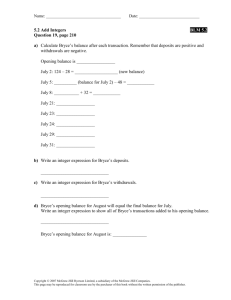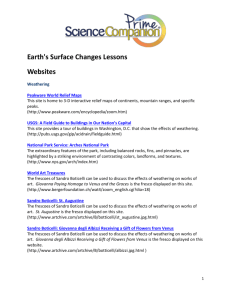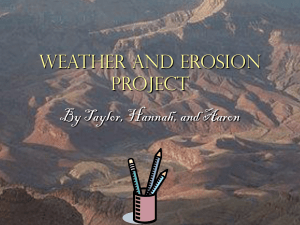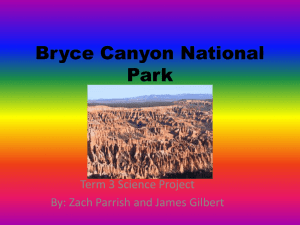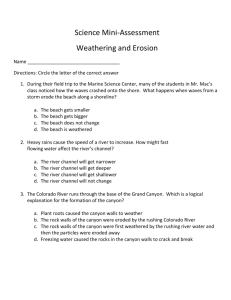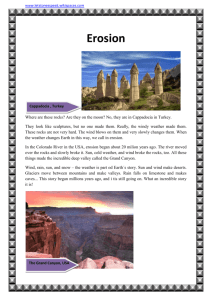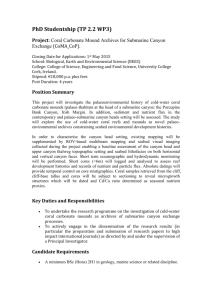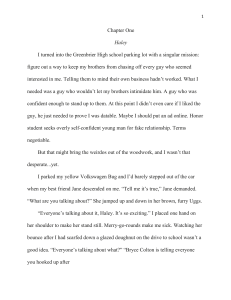Bryce_Out
advertisement
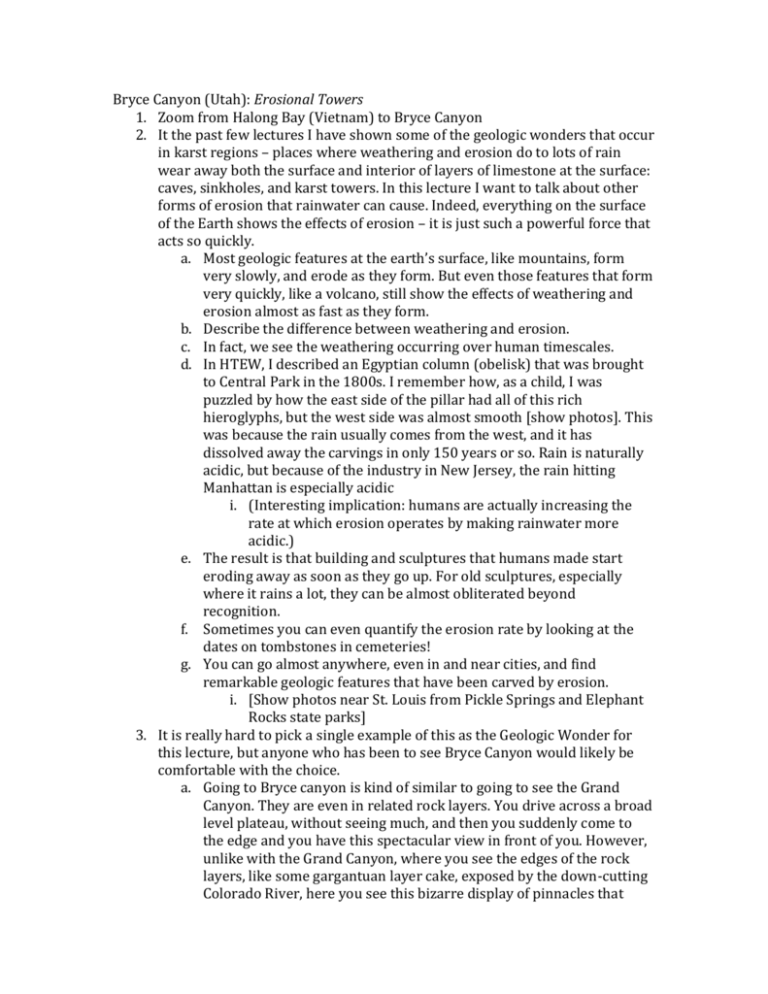
Bryce Canyon (Utah): Erosional Towers 1. Zoom from Halong Bay (Vietnam) to Bryce Canyon 2. It the past few lectures I have shown some of the geologic wonders that occur in karst regions – places where weathering and erosion do to lots of rain wear away both the surface and interior of layers of limestone at the surface: caves, sinkholes, and karst towers. In this lecture I want to talk about other forms of erosion that rainwater can cause. Indeed, everything on the surface of the Earth shows the effects of erosion – it is just such a powerful force that acts so quickly. a. Most geologic features at the earth’s surface, like mountains, form very slowly, and erode as they form. But even those features that form very quickly, like a volcano, still show the effects of weathering and erosion almost as fast as they form. b. Describe the difference between weathering and erosion. c. In fact, we see the weathering occurring over human timescales. d. In HTEW, I described an Egyptian column (obelisk) that was brought to Central Park in the 1800s. I remember how, as a child, I was puzzled by how the east side of the pillar had all of this rich hieroglyphs, but the west side was almost smooth [show photos]. This was because the rain usually comes from the west, and it has dissolved away the carvings in only 150 years or so. Rain is naturally acidic, but because of the industry in New Jersey, the rain hitting Manhattan is especially acidic i. (Interesting implication: humans are actually increasing the rate at which erosion operates by making rainwater more acidic.) e. The result is that building and sculptures that humans made start eroding away as soon as they go up. For old sculptures, especially where it rains a lot, they can be almost obliterated beyond recognition. f. Sometimes you can even quantify the erosion rate by looking at the dates on tombstones in cemeteries! g. You can go almost anywhere, even in and near cities, and find remarkable geologic features that have been carved by erosion. i. [Show photos near St. Louis from Pickle Springs and Elephant Rocks state parks] 3. It is really hard to pick a single example of this as the Geologic Wonder for this lecture, but anyone who has been to see Bryce Canyon would likely be comfortable with the choice. a. Going to Bryce canyon is kind of similar to going to see the Grand Canyon. They are even in related rock layers. You drive across a broad level plateau, without seeing much, and then you suddenly come to the edge and you have this spectacular view in front of you. However, unlike with the Grand Canyon, where you see the edges of the rock layers, like some gargantuan layer cake, exposed by the down-cutting Colorado River, here you see this bizarre display of pinnacles that have no apparent means of formation. In fact, Bryce Canyon isn’t really a “canyon” at all because it hasn’t formed from a river. It is really an Amphitheatre, but we can still call it by its common name, Bryce Canyon. i. I remember standing there, in awe, mystified how something like this could form out the solid layers of rock. ii. First of all, there are the incredible colors – reds and oranges and yellows. iii. And then there are the thousands of pinnacles. Many of them have unusual totem-pole looking structures that may actually be wider at the top than in the middle. These are called Hoodoos, and Bryce Canyon has the densest display of hoodoos anywhere in the world. 4. So, how does something like the amphitheatre of Bryce Canyon form? Some of the geological processes that have created this we have seen before – like depositing sedimentary layers, jointing and cracking, differential erosion. But things had to happen in just the right way for this amazing display of hoodoos to exist. a. Things began more than 100 million years ago, when an inland ocean called the Cretaceous Seaway existed here in Utah, surrounded by mountains on either side (California and Colorado). b. If you look at a geologic cross-section of Arizona and Utah, you see that the rock layers of the Grand Canyon and Bryce Canyon are related, but the layers at Bryce are way on top younger. i. Youngest rocks at rim of grand canyon (Kaibab Plateau) are about 240 Ma. ii. Oldest rocks at Bryce are about XX years old! These rocks formed as ocean sediments during the time of the Cretaceous Seaway, way on TOP of the rock layers that are exposed in the Grand Canyon. c. Starting about 70 million years ago the Rocky Mountains began to form; this uplift closed the cretaceous seaway, with later sediments (which would become Bryce!) forming in large freshwater inland seas. d. These sediments, beginning about 40 million years ago, consisted of alternating layers of limestones, siltstones, and mudstones. e. The Colorado Plateau began its major uplift about 20-15 million years ago, and this was important for two reasons: faulting and jointing. i. There wasn’t just one Colorado Plateau – there were actually several that were separated by faults, that brought different parts of the plateau to different elevations. ii. In the process, it exposed the edges of the layers where there were faults very important because it allows for accelerated erosion. iii. Bryce canyon exists along one of these faults – the Paunsegunt Fault, and the topmost layer of Bryce is called the Paunsegunt plateau (means home of the beaver). iv. The uplift also played a role in creating a set of vertical joints that run throughout Bryce – just like in Halong Bay. These joints provide channels for water to flow through, causing weathering to cut down along the joints. v. The mechanism for the weathering, unlike Halong Bay, however, is freezing. 1. Explain frost wedging here (can be >250 freeze/thaw days per year) f. The fact that Bryce Canyon sits at the edge of the Paunsegunt Plateau is not accidental. The top layer of the plateau is a resistant carbonate rock called dolomite (named after the dolomite mountains in Italy). It erodes from the plateau very slowly. However, at the edge of the plateau softer rocks are exposed (the shales and siltstones and mudstones), and the erode quickly, undercutting the dolomite cap stone. i. It is this capstone that is often seen as the white heavy rocks on the tops of the hoodoos. (explain) g. So, the process is plateau fins windows hoodoos. h. Where there are more resistant rocks, the hoodoos are thicker. 5. Though Bryce is huge and seems like it could last forever, it is actually a fairly recent formation and is eroding away quickly. a. Erodes headward and down about 1 cm/year. Doesn’t sound like much, but that is 1 m/100 years, or over 30 feet in just 1000 years. In geologic time, it won’t be long before its gone. b. In fact, even humans hiking though the canyon, loosening weak shales along the trails, can significantly accelerate the rate that the hoodoos are eroding. 6. Another striking feature of Bryce is the striking colors – common for Badlands topography a. Due to slightly different chemical compositions; these are mostly metal oxides; The brown, pink and red colors are from hematite (iron oxide; Fe2O3); the yellows from limonite (FeO(OH)·nH2O); and the purples are from pyrolusite (MnO2) 7. Top 5: a. Western US (Arches (Utah), Monument Valley (Utah), Bizsti Badlands (New Mexico), Sedona (Arizona), South Dakota badlands, Chricahua National Monument (Arizona), City of Rocks (Idaho), The Wave (Arizona) b. Cappadocia (Turkey) c. Lena River (Russia) d. Wuling Yuan Park (China) Questions: 1) It is likely that in the not too distant geological future, Bryce canyon will capture a nearby river. What do you think will happen to Bryce Canyon when this happens? 2) The different shapes and colors of the hoodoos are due to different rock compositions? Why are there these different rock types in the layers there? What does that say about the geologic history there?
